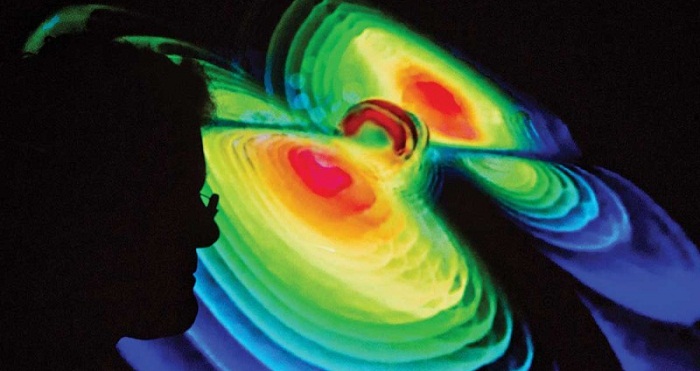This particular signal, picked up by LIGO’s two observatories on 14 September 2015, was made by two black holes, each about 30 times the mass of the sun, colliding with each other. This immediately resolved one open question for astronomers: before the signal came in, the very existence of such black hole binaries was contested. Further observations could tell us more about exotic objects like neutron stars and supernovas.
But that’s just the beginning. Gravitational waves will allow us to explore fundamental physics and possibly even peer back to the universe’s earliest moments. Here are four mysteries of cosmology that may finally be solved in the era of gravitational wave astronomy.
1. Dark energy
Put several detections together and we should gain insights into the history and composition of the universe as a whole, says Avi Loeb of Harvard University. Combining the signals from a number of black hole mergers, for example, could help understand the nature of dark energy, which is causing the universe’s expansion to accelerate.
From the “shape” of the signal – how the waves’ frequency and amplitude rise and fall – we can discern the sizes of the black holes involved, and determine how strong the event was at its source. Comparing how powerful it really was to the faint vibrations LIGO detected tells us how far away it occurred. Combined with observations from standard telescopes, this can reveal how space has expanded during the time the waves took to reach us, providing a measure of dark energy’s effect on space.
This measure should be stronger and more reliable than anything we have used so far. Spotting just a few black hole mergers would change everything, Loeb says. “If you have tens of them, it will be a new branch in cosmology.”
2. Equivalence principle
Other researchers are hoping to use gravitational wave signals to put Einstein’s general theory of relativity through even more stringent tests. One way is to investigate the equivalence principle, an assumption that gravity affects all masses in the same way.
“In the age of GPS and space travel, where even minute deviations from the assumed theory of gravity would have major consequences, it is of enormous importance,” says XueFeng Wu of Purple Mountain Observatory in Nanjing, China.
Erminia Calabrese, an astronomer at the University of Oxford, sees gravitational waves as a way to check whether gravity behaves as relativity predicts it should over large distances.
“If their strength fell off with distance in a surprising way, we could detect this with the upcoming LIGO data,” she says.
3. Cosmic inflation
LIGO’s success could see more gravitational wave detectors being built around the world. More sensitive detectors, working at shorter wavelengths than LIGO, may allow us to sense primordial gravitational waves from the very young universe. These waves should have been produced in the period of inflation – the tremendous cosmic growth spurt in the first instants after the big bang.
Unlike photons and other electromagnetic radiation, they would have travelled freely through the newborn universe. At the moment we can only see as far back as 380,000 years after the big bang, when the universe became transparent to light.
“We can potentially see almost all the way to the big bang,” says Dejan Stojkovic of the State University of New York in Buffalo. LIGO itself won’t be able to sense such vibrations, but the detector’s success raises hopes that future experiments will get off the ground. “Now that we know gravitational waves exist, it will be much easier to convince people to invest money and make all kinds of gravitational wave detectors,” Stojkovic says.
4. Grand unified theory
Gravitational waves may even point the way toward a grand unified theory of the universe. Models predict that at some point in the universe’s history, all four fundamental forces were united into a single force. As the universe expanded and cooled, the forces split off from one another in a series of as yet poorly understood events.
“Gravitational wave observatories that can detect much shorter wavelengths could probe those,” Stojkovic says.
LIGO team member Daniel Holz at the University of Chicago thinks this is just the beginning. “Every time we’ve opened a window to the universe, we’ve found all sorts of unexpected things,” Holz says. “I’d be surprised if I wasn’t surprised.”
More about:
















































